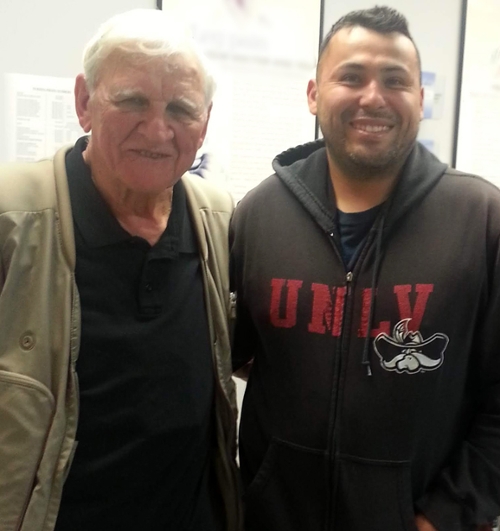
Cross-continental connections
Support between a donor alumnus and student blossoms into a friendship
By Amanda WoroniukThe high cost of tuition can make medical school a barrier for potential students. However, thanks to an alumnus’ generosity through the funding of a bursary, one student was able to pursue his dream of a medical education and is now making a difference as a physician in Northern Saskatchewan.
“It changes a life during the most stressful time of your career. It covered the tuition for each of the four years and made a huge difference,” said Dr. Jonathan Starr (MD’14) about the financial assistance.
The support Starr received was through medicine alumnus Dr. William Kindrachuk (MD’53). For Kindrachuk, the decision to support an Indigenous medical student by paying his tuition to the College of Medicine was an easy one. “I’ve always had an interest in Aboriginal health,” said Kindrachuk citing reasons that prompted him to give. “I decided I was going to sponsor a medical education. I calculated that out of each graduating class, if we have one person do what I did we wouldn’t have a shortage of Aboriginal doctors very quickly.”
“Medical school was the most stressful time of my life. And looking back, his help made a huge difference in how I am now,” adds Starr.
Starr is a general physician in Pelican Narrows, a community located approximately 500 kilometres north of Saskatoon. Having the help meant a lot for Starr, a member of the Starblanket First Nation, especially as he balanced the demands of medical school with the responsibilities of raising a family.
“Prior to that, it was keeping close track of what we’re spending money on,” said Starr, who works in the community on a rotational basis. “It took a lot of worry out of growing a family. It felt like somebody cared about where I was going to be.”
Kindrachuk grew up in Saskatoon and completed two years of training in the School of Medical Sciences (as the program was known at the time), where he earned a Bachelor of Science degree. After graduation, he went on to specialize in pediatrics and moved to the Chicago area.
During medical school in the 1950s Kindrachuk noted the absence of Indigenous health issues within his education. “It wasn’t something that was done at the time. One of my medical school classmates spent a summer with Indian Affairs, now known as Indigenous and Northern Affairs, as a provider of health care, and he told me about what the situation was like there. I had some idea that it wasn’t up to par.
The association between the two doctors has blossomed into something of an informal mentorship. The pair have met on several occasions, including at Starr’s convocation in 2014.
“He’s calls me every once in a while and I call him. He’s given me advice and mentored me,” said Starr. “Right now, I’m trying to find a conference that takes place in Chicago, just so I have an excuse to go down there. I enjoy talking with him and seeing him.”
This past summer, Kindrachuk was in Saskatoon to attend the Highlights in Medicine alumni reunion and he made the trip to Pelican Narrows to visit Starr. Kindrachuk was happy to see his friend, although he was shocked when he saw the village’s limited medical equipment. He expressed frustration that remote communities don’t have access to the level of care found in urban centres, a struggle that is common in remote areas across the country.
“He is serving a community of 5,000 people in a rural, isolated area,” said Kindrachuk. “I was interested what he was doing and how his job was going. It was a very worthwhile venture on my part.”
For Starr, the visit provided a boost of encouragement.
“It was a complete surprise, because we hadn’t confirmed it would happen. I got here on the Friday and he showed up on the Monday. It made my week,” said Starr. “I think that two-week period was the best two weeks I’ve had out here in Pelican Narrows. And it started with that.”
